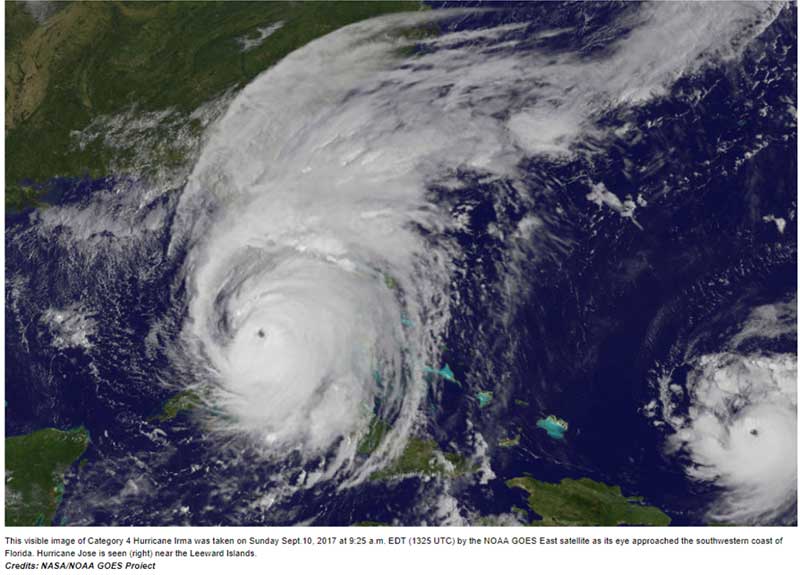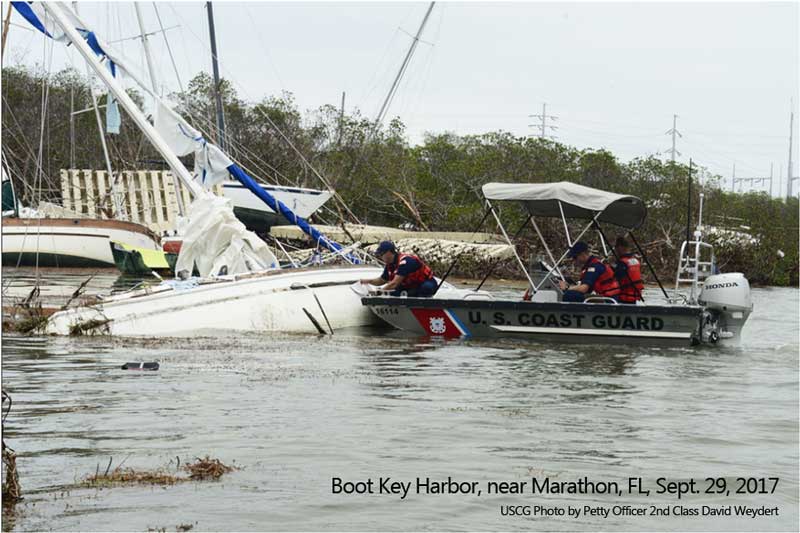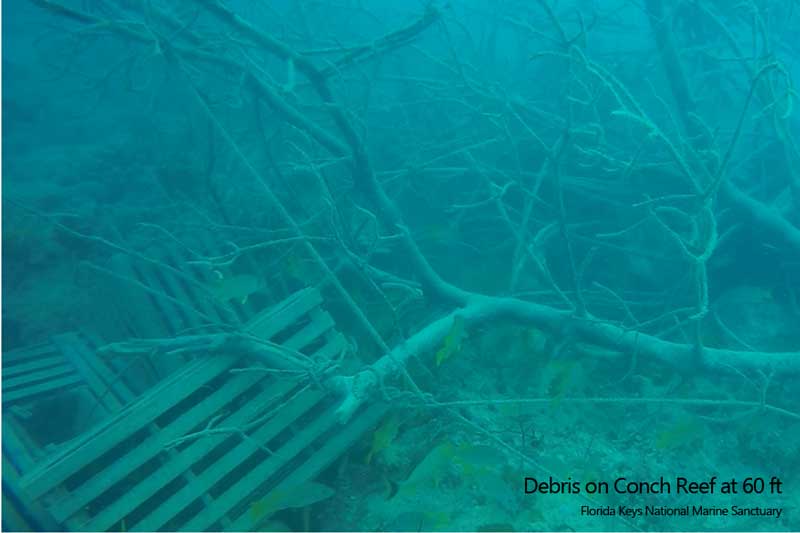Reel News Casts 2017
News > 2017
Monster Hurricanes and the Effects on Reefs and Fishing
2017 was the most active Atlantic hurricane season since 2005. Two consecutive massive, record setting Category 5 hurricanes, Irma and Maria, made landfall in the USA thankfully as Category 4 storms but nevertheless created massive destruction to Puerto Rico and Florida. As this article is being written, 41 days have passed since Irma destroyed our area in Naples/Marco Island and the effects (debris, blue tarps, downed power wires) are still quite visible in all of south Florida.
NASA has a great page showing each of the storms with fantastic imagery on each storm, this link goes to Irma and look to the left to see the other storms. https://www.nasa.gov/feature/goddard/2017/irma-atlantic-ocean As you can see in the image below, the storm was so massive it completely covered the state of Florida into Georgia.

When the storm approached Florida it literally emptied Florida Bay and the waterways of the Gulf all the way up to the Tampa area. We saw images of fish and most notably manatees stranded on bare seafloors. It was heart wrenching seeing those images. Luckily it only lasted for a few hours until the hurricane passed which in turn brought in a rush of high waters. Many areas were inundated with water especially the Keys. Sadly our area in Naples saw a lot of flooding too after a 4 foot storm surge.
Boating
Cleaning up displaced boats and debris from our waterways is one massive task. Currently 850 boats have been removed from Florida waters with the majority coming from the Keys. For the next year one must be very cautious navigating both inshore and offshore waters, especially in the Keys. Not only are there sunken boats aimlessly floating with the currents, there is debris from docks, yards, trees, house parts, and boats adrift. There was even a houseboat found floating in the mid-Gulf off Tampa the week after the storm. In the days following Irma, we saw images of US1 the Overseas Highway in the Keys literally piled 8 feet high with debris. They had to use what looked like snow plows to move the debris to one lane on the highway to open up the other lane. In some areas it was one lane for weeks until the debris on the roadway could be cleared. This will give you an idea of how much debris went into the waterways, especially with a reported 25% of the homes in the Keys totally destroyed, not to mention the business destroyed too. This video says it all.
Most waterways in Florida were effected by Irma in one way or another. Do not assume familiar waterways and channels are still the same. Many waterways are now littered with debris. Some waterways are now deeper than before and others have been filled with shifting sand making them unnavigable. View FWC's images of the after effects of the storm to get an idea of how the waterways were effected.
Many aids to navigation markers are now broken off or completely missing. Submerged marker piling may not be visible when navigating waterways. Extreme caution and common sense should be taken when navigating most waterways in southern Florida.
Severe beach erosion has been reported on the east coast of Florida, especially in Martin County, giving new meaning to waterfront property. This also makes for a changed landscape when entering harbors from the sea and nautical charts could be off a bit. Again, use common sense when boating.
A resident of Marco Island reported seeing a boat float by dragging it's dock! That is testament to tying your boat to the pilings, not the dock itself. Speaking of that, we saw on the news just after Irma hit on September 12 an image of a very expensive sports fishing boat tied to it's lift in the middle of US1 in the Keys. Always tie the boat to the lift then tie the lift to the pilings. For more info see Preparing Your Boat for Hurricanes.
In the Upper Keys we have heard many reports over the past few weeks of a 40 foot section of a 100 foot boat appearing then disappearing in the waterways from Long Key to Key Largo. Boaters in this area should use extreme caution when navigating these waterways. There is more in the water than wayward boats - washing machines & dryers, lobster traps, furniture, wood of all sorts, trees, etc. The Keys literally went under several feet of salt water during the storm and anything not tied down that could float away did.

To report displaced vessels please note the GPS location of the boat and contact authorities for vessel removal.
Reefs
The reefs in the Keys took a beating during Hurricane Irma but they are in remarkably good shape with all things considered. Some reefs were decimated, others just scoured with most having some sort of damage due to heavy waves beating them during the storm and lobster traps slamming into coral. Sadly large sections of staghorn coral?were damaged in many areas.
In the days that followed Hurricane Irma, we watched a new reporter who boarded a boat at Long Key and reported what he saw as he traveled to Marathon on the Oceanside. Well he stated he saw what looked like snow mountains after a blizzard which was mountains of coral, broken off from the massive wave action of the storm then pushed ashore into large piles. I have not seen images of this but hearing this actually brought me to tears! The good news on this is I have read many, many reports of surveys on the reefs in the Keys and not one stated mass destruction. A lot of soft coral is gone and some hard corals were broken off throughout the reefs, but all reefs survived remarkably. There is debris on some reefs which is not surprising and again, boaters should be cautious when approaching shallow reefs.

The major effect on the reefs from Hurricane Irma was the removal of sand from reefs, creating new crevices and exposing new thing. It has been reported that many reefs are now a foot deeper, many much more that that. And new artifacts have been exposed from this natural excavation of the seafloor from the storm. This actually could open up a new chapter in artifact discovery in Florida. Please do not touch or remove any artifacts you may find; record their location and report them to local authorities. It is unlawful to remove artifacts from Florida waters. See Modern Day Treasure Hunting for more info.
So I wondered where all the seafloor sand went now that the reefs are a little deeper. Well from the video's I've seen a lot of it filled canals and washed up on land. At Key Colony Beach a condo building had sand fill it's parking garage half way up the door, say 3 feet of sand filled the whole area!
The largest reefs have already been surveyed and all ships in the Keys endured the storm with little damage or movement. Many are now deeper due to the sand being washed away from under them during the storm.
Hundreds of mooring buoys are now missing or have had their ID numbers washed away. If you find a mooring buoy, please note its location and report it to local authorities or in the Keys to FKNMS, visit this page to see what the buoys look like and where to report. Most mooring buoys provided for recreational boating for anchoring will be replaced quickly to avoid further damage to reefs from anchors. Please be very mindful anchoring in the coming months until buoys are replaced.
Currently surveys are being undertaken to assess the state of the Florida reef track. The Florida Keys National Marine Sanatory, in conjunction with Monroe County, FWC, the US Coast Guard, and other agencies are involved in recovery and cleanup efforts in the Florida Keys.
The east coast of Florida reefs survived remarkably although debris in the waterways will be an ongoing problem, especially wayward vessels. Check out this video post-Irma.
Reef Reports Post-Irma
| Site ID | Site Name | Location | Report |
| MU-37 | The Elbow | Upper Keys | A pink, fluffy growth on the reef |
| MU-74 | Spiegel Grove | Upper Keys | Bow has minor damage |
| MU-78 | Benwood | Upper Keys | A large anchor has been uncovered |
| MU-96 | Molasses Reef | Upper Keys | A lot of coral broken off and litters the seafloor |
| MU-104 | Duane | Upper Keys | Suffered minor damage to its smokestack |
| MU-114 | Conch Reef | Upper Keys | Lobster traps and vegetation debris on the reef |
| ML-94 | Hoyt Vandenberg | Lower Keys | The ship pivoted, the bow is 8 feet deeper, the stern 4 feet deeper |
Fishing
After the hurricanes hit the waters were all stirred up and cloudy, making fishing a little challenging. And frankly a little dangerous with all the debris in the waterways. But the good news, the fish are still there! Fish do not leave after the storm, they just find new homes if their favorite hole was displaced. The waters have now cleared and are remarkably back to normal. Nature has an amazing way of bouncing right back.
For visitors, charter boats are your best option to get out fishing safely. They know the waterways, where the fish are and frankly they need your business, it has been a very rough year for all of them throughout Florida.
As far as industries like ours that are dependant on fishing, we have felt the pain of this hurricane. Our business was down 75% for almost a month after the hurricane. Charter boat companies, marinas, bait and tackle shops and dive shops have suffered greatly since the storm. Who wants to go fishing when they have to put their lives back together after a hurricane? We understand and are also putting our lives back together. September and October are the leanest months for the fishing, boating & diving industries in Florida, so this hurricane could not have hit at a worse time. Luckily business is now coming back and Florida is ready to welcome back visitors. All we can say is get out, and "go fishing!"
Liz Lombardi, Naples FL October 21, 2017










